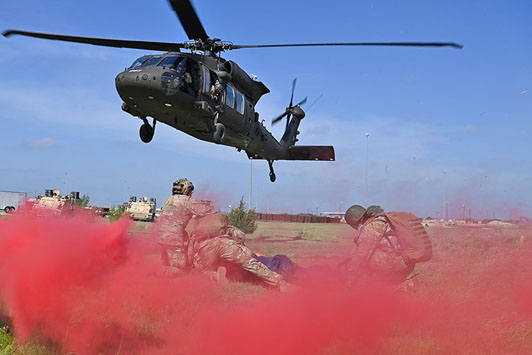Researchers evaluated combat-related extremity wound infection studies including the Trauma Infectious Disease Outcomes Study and the Trauma-Associated Osteomyelitis studies.
When it comes to the battlefield, one of the greatest challenges that combat medical personnel face is combat-related extremity wound infections (CEWIs). Infections increase morbidity and may prolong Warfighter recovery. In particular, blast-injuries resulting in amputation are susceptible to serious wound infections. These infections can impact survivability and cause long-term health problems for Service members. The Uniformed Services University of the Health Sciences (USU) Infectious Disease Clinical Research Program (IDCRP) is Department of Defense's (DOD's) global, multi-center, collaborative clinical research network dedicated to reducing the impact of infectious disease threats in the Military Health System and improving care of the Warfighter.1
In this study2, the researchers conducted secondary data analysis on CEWI research from the Trauma Infectious Disease Outcomes Study and the Trauma-Associated Osteomyelitis study. The data consisted of information on military personnel with deployment-related trauma between 2009-2014, including injury patterns and infection risk factors for those with one or more extremity wounds. The researchers focused on several areas including, polytrauma characterization, combat-related extremity wound infection epidemiology, CEWI risk factors, and post-trauma antibiotic prophylaxis. In addition, the USU IDCRP collected data from combat casualties with open fractures in the tibia, femur, and upper extremities (2003-2009) through the Trauma-Associated Osteomyelitis study and conducted analyses to understand the incidence, recurrence, and risk factors for osteomyelitis.
The researchers found several factors were independent predictors of CEWIs during hospitalization, including injury pattern, mechanism, and severity. In many cases (~81%), the patients sustained blast injuries through improvised explosive device detonation. Of those that sustained blast-related injuries, about 25% later developed CEWIs. In addition to the injury patterns and infection risk factors, the researchers reviewed data on combat-related open fractures of the tibia, femur, and upper extremity to identify risk factors for bone infections (also known as osteomyelitis). Compared to patients with an open fracture or an open soft tissue wound, patients with amputations, predominately caused by blast injuries, had a higher proportion of infections (47% of 212 patients with traumatic amputations). Below-knee amputation (or transtibial amputation) is one of highest risk factors among open tibia fractures resulting in osteomyelitis. The research showed that, after discharge, 28% of patients with extremity trauma were diagnosed with a new or current CEWIs. Among individuals who had tibia osteomyelitis during their hospitalization, 28% also had a recurrent infection. The researchers identified these recurrent bone infections as polymicrobial (containing different organisms).
Researchers continue to make progress in supporting the development of a clinical practice guideline for the treatment of combat-related infections. Blast injury remains a significant threat, and proper medical management approaches to treat these infections are important to prevent further injury and long-term health issues for Service members. Future research from the USU IDCRP will consider the effectiveness of deep-soft tissue infection management (e.g., clinical outcomes), the development of a clinical practice guideline, and, as part of a collaboration with the Veterans Affairs St. Louis Health Care System, examine the long-term impact of extremity trauma and infections on Service members, including mental health, social factors, and healthcare utilization.

1 Uniformed Services University Infectious Disease Clinical Research Program. Retrieved from https://idcrp.usuhs.edu/home
2 Joseph L Petfield, MC, USAR, Louis R Lewandowski, MC, USN, Laveta Stewart, PhD, MSc, MPH, Clinton K Murray, MC, USA, David R Tribble, MD, DrPH. IDCRP Combat-Related Extremity Wound Infection Research. Military Medicine, Volume 187, Issue Supplement_2, May-June 2022, Pages 25–33. https://doi.org/10.1093/milmed/usab065
This work was conducted by the Infectious Disease Clinical Research Program, a DoD program executed through the Uniformed Services University of the Health Sciences, Department of Preventive Medicine and Biostatistics through a cooperative agreement with The Henry M. Jackson Foundation for the Advancement of Military Medicine, Inc. This project has been funded by the National Institute of Allergy and Infectious Diseases; the National Institute of Health (Inter-Agency Agreement Y1-AI-5072); the Defense Health Program; the U.S. DoD, under award HU0001190002; the Department of the Navy under the Wounded, Ill, and Injured Program; and the Defense Medical Research and Development Program.
Your 15 minute session will timeout in approximately 10 minutes.
If you're in the middle of entering information, please close this warning and save your progress (if possible) or finish up your task.
If your session fully times out, you will lose any un-saved work.
Your current Blast Injury Research Program session has expired.
Your next click will take you away from the private area, and you will lose any work you have in-progress.
Please enter your email address, and try again.